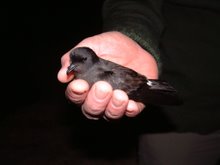 A storm petrel caught on the night of 26-27th June was carrying an Italian ring. The Mediterranean storm petrel population is genetically divergent from the Atlantic population, and is generally assumed to be dispersive but not to migrate long distances. As far as we know, this is the first time a stormie from the Mediterranean breeding range has been caught in Atlantic waters (though do let us know if you know of other instances!). We will have to wait to find out the details of its genetics and of where and when this bird was ringed in Italy, but this movement provides evidence that there is at least some exchange of storm petrels between Mediterranean and Atlantic waters.
A storm petrel caught on the night of 26-27th June was carrying an Italian ring. The Mediterranean storm petrel population is genetically divergent from the Atlantic population, and is generally assumed to be dispersive but not to migrate long distances. As far as we know, this is the first time a stormie from the Mediterranean breeding range has been caught in Atlantic waters (though do let us know if you know of other instances!). We will have to wait to find out the details of its genetics and of where and when this bird was ringed in Italy, but this movement provides evidence that there is at least some exchange of storm petrels between Mediterranean and Atlantic waters.Magnus Robb, who is completing a book about storm petrels for publication in the autumn, has emailed to say that there are 2 records of stormies ringed on Malta and found dead in Altlantic waters:
1. 15/09/1989: A bird found dead on Ameland, one of the Frisian islands strung along the northern coast of the Netherlands. Ringed in a colony in Malta on 10/07/1971.
2. 02/02/1990: A bird found dead on the Côte Sauvage, La Tremblade, Charente-Maritime on the Atlantic coast of France. Ringed on Malta on 24/05/1986.
The new book 'Petrels night and day' by Magnus Robb, Killian Mullarney & The Sound Approach, will be out in the autumn. If you'd like to order a copy, email Magnus on: magnus.robb@xs4all.nl
Renzo Ientile has been in touch from Italy to say that this bird was ringed in Marettimo, Italy, as a chick in the nest on 16/07/04, thereby confirming that it was Italian by birth -apparently the first definite record of a Mediterranean storm petrel (Hydrobates pelagicus melitensis) in Atlantic waters!
These details will all be formally confirmed in due course via the EURING bird ringing database.


2 comments:
Hi:
A bit of historical info. that you may not have. It has long been thought that at least a part of the Med. population exited to the Atlantic. Mainwood 1976(Ringing & Migration 1(2): 98-104) thought that Med. birds were partial migrants and that some birds at least might go out in to the Atlantic,join with Atlanic birds and winter in southern hemisphere waters off South Africa. Conversely, Dean Hashmi, in 'Birds of the Strait of Gibraltar' (1992) and also pers.comm., found that the majority of birds birds seen in the period September-November were entering the Med., in theory just when they should be leaving. Ernest Garcia commented to me years ago that birds were present in the Strait and that he would not be in the least surprised to know that at least a part of the population left the Med. in the winter months. The problem is, of course, the variance of data. Perhaps these are non-beeders which remain out in the Atlantic?
All the info. given and the references is in 'Aves marinas de España y Portugal' (Lynx. 1997).
Regards,
Andy Paterson
Torremolinos, Spain
Hi Andy, thanks for this information -glad we can add another small piece to the jigsaw!
Rob
Post a Comment